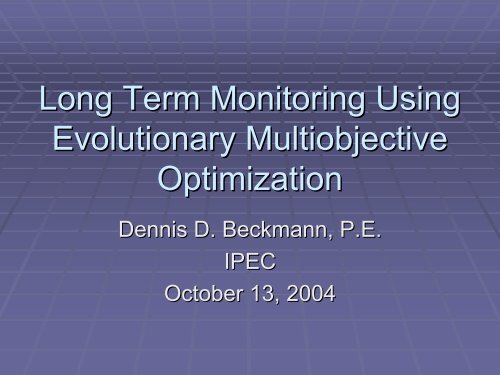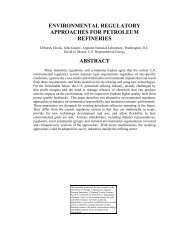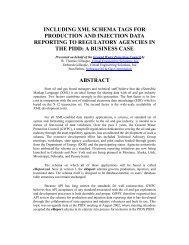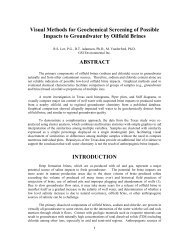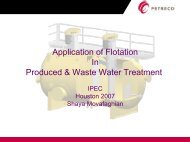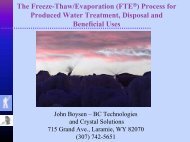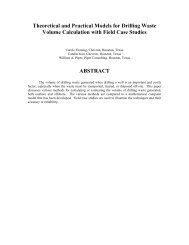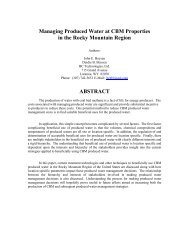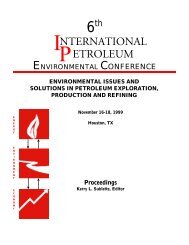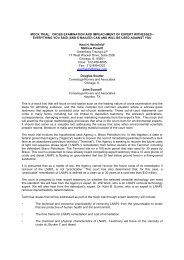Development and Case Study - IPEC
Development and Case Study - IPEC
Development and Case Study - IPEC
Create successful ePaper yourself
Turn your PDF publications into a flip-book with our unique Google optimized e-Paper software.
Long Term Monitoring Using<br />
Evolutionary Multiobjective<br />
Optimization<br />
Dennis D. Beckmann, P.E.<br />
<strong>IPEC</strong><br />
October 13, 2004
Authors<br />
• Barbara Minsker, , National Center for<br />
Supercomputing Applications at the<br />
University of Illinois<br />
• Peter Grove, Moire, , Inc.<br />
• Jon Greetis, , Delta Environmental<br />
• Megna Babbar, , UIUC<br />
• Dennis Beckmann, Atlantic Richfield/BP
Agenda<br />
• Introduction<br />
• Background on method<br />
• <strong>Case</strong> <strong>Study</strong> 1 – Michigan site<br />
• Detailed analysis<br />
• <strong>Case</strong> <strong>Study</strong> 2 – New Jersey site<br />
• Brief discussion<br />
• Conclusions
Perspective/Objective<br />
• Environmental business grew up with many rule<br />
of thumb approaches.<br />
• Now becoming more quantitative <strong>and</strong> sophisticated<br />
• Difference between delineation <strong>and</strong> monitoring<br />
• Likely have some redundancy in the data<br />
• Cost of monitoring is very significant<br />
• Waste money collecting redundant data<br />
• Optimize monitoring in a sound manner<br />
• Considering both science <strong>and</strong> math<br />
• Eliminate data redundancies
Background<br />
• What’s important here?<br />
• Statistical approach<br />
• Use of Genetic Algorithm<br />
• Optimize among several variables
LTM Optimization Process<br />
1 2 3<br />
Define objectives<br />
<strong>and</strong> constraints<br />
Create interpolation<br />
model<br />
Create population<br />
of monitoring<br />
desgns<br />
4<br />
Evaluate design using objectives <strong>and</strong><br />
constraints<br />
5<br />
Repeat until<br />
convergence to<br />
optimal solution<br />
Apply Genetic Algorithm operations<br />
to create new population
Optimization Process<br />
• Use genetic algorithms to search for monitoring<br />
designs that best meet the objective functions<br />
<strong>and</strong> constraints<br />
• When more than one objective exists, find optimal<br />
tradeoffs among objectives (e.g., cost vs. errors)<br />
• Optimization process was implemented in Multi-<br />
objective Long Term Monitoring Optimizer<br />
Software (M-LTMO) developed at University of<br />
Illinois <strong>and</strong> Moire<br />
• Automated interpolation model fitting <strong>and</strong> selection<br />
• Multiobjective optimization to find monitoring designs<br />
that best meet objectives
Objectives <strong>and</strong> Constraints<br />
• Identify Decision Variables<br />
Is each well sampled or not?<br />
Optimization problem is to identify which wells are “in”<br />
2 x possible sampling plans:<br />
for 36 wells that is 7x10 10 different plans<br />
• Identify Objective Functions<br />
• Minimize cost: here, that is the just the number of wells<br />
• Minimize the maximum error between actual concentrations <strong>and</strong><br />
those estimated with the subset of wells being considered<br />
• Identify Constraints<br />
• None in this formulation
Error Objective Functions<br />
• Error objective for benzene<br />
• 5 ppb maximum acceptable error<br />
• Error objective for BTEX<br />
• 100 ppb maximum acceptable error<br />
• Locations for measuring error are important<br />
• At monitoring wells only<br />
• Don’t measure error at grid nodes because no data<br />
support (actual values), only modeled values
Interpolation Modeling Process<br />
• Identify key contaminants of concern<br />
• Create spatial grid for interpolating COC<br />
concentrations<br />
• Fit interpolation models<br />
• Such as ordinary kriging, quantile kriging,<br />
inverse distance weighting, etc.<br />
• Test interpolation model fit <strong>and</strong> choose<br />
model with best performance<br />
• Quantile kriging performed best
Interpolation Model Evaluation<br />
• Use cross validation<br />
• Eliminate one well from network<br />
• Interpolate concentration at well using data<br />
from other wells<br />
• Compare actual vs interpolated concentration<br />
• If the error is small, then well is redundant<br />
• Repeat for all wells
<strong>Case</strong> <strong>Study</strong> 1 - Michigan<br />
• Remedial Actions began in 1987 when a leaking pipeline<br />
gasket was discovered<br />
• Catastrophic Release - estimates of the volume released<br />
are in the range of 350K gallons<br />
• 14 years of monitoring data support plume stability<br />
• BTEX concentrations reduced 80-80%<br />
80%<br />
Remediation History<br />
No LNAPL observed after 1993<br />
Groundwater Treatment / Product Skimming * 118,000 gals of LNAPL recovered<br />
No LNAPL observed after 1993<br />
Air Sparging<br />
Groundwater Treatment / Product Skimming * 118,000 gals of LNAPL recovered<br />
Air Sparging<br />
MNA<br />
MNA<br />
1987 1989 1991 1993 1995 1997 1999 2001 2003
LTM Scenario / Drivers<br />
• 36 wells currently being monitored<br />
• 30 years of Post Closure Monitoring<br />
required<br />
• Optimization can be used to identify<br />
redundant data points<br />
• There is a cost penalty for collecting<br />
redundant data<br />
• Spatial <strong>and</strong> temporal analyses are possible<br />
• Only spatial redundancy addressed at this site
N<br />
26<br />
<br />
MW-63<br />
25<br />
<br />
MW-60<br />
36<br />
MW-82D<br />
MW-61<br />
27<br />
<br />
MW-74<br />
24<br />
<br />
<br />
MW-51<br />
MW-75D<br />
35<br />
<br />
MW-81<br />
21<br />
<br />
MW-54<br />
20<br />
MW-53<br />
19<br />
28<br />
18<br />
<br />
MW-49<br />
17<br />
<br />
MW-48<br />
16<br />
<br />
MW-46<br />
<br />
<br />
MW-44<br />
23<br />
15<br />
MW-56<br />
34<br />
<br />
MW-80<br />
12<br />
<br />
MW-41<br />
<br />
7<br />
<br />
MW-28B<br />
MW-28A<br />
6<br />
8<br />
MW-27<br />
22<br />
<br />
MW-55<br />
9<br />
<br />
MW-31<br />
<br />
<br />
<br />
MW-42<br />
<br />
MW-19<br />
4<br />
MW-21<br />
11<br />
13<br />
MW-36<br />
3<br />
5<br />
<br />
MW-25<br />
2<br />
<br />
MW-16B<br />
14<br />
<br />
MW-43<br />
10<br />
<br />
MW-34<br />
29<br />
<br />
33 MW-76 30<br />
31<br />
<br />
<br />
32<br />
MW-79<br />
<br />
MW-77<br />
MW-78A<br />
MW-78B 1<br />
<br />
MW-12A<br />
Legend:<br />
<br />
Current Monitoring Network - 7-Jan-04<br />
14 Interpolation ID<br />
MW-21<br />
Monitoring Well ID<br />
0 100 200 Feet<br />
Site Map<br />
Date:<br />
16 Jan 2004
• Of the 36 wells, the following numbers of wells were<br />
predicted sufficiently accurately during cross-validation:<br />
• Benzene: 17 (within 5 ppb)<br />
• Toluene: 32 (within 100 ppb)<br />
• EthylBenzene: : 28 (within 100 ppb)<br />
• Xylene: 23 (within 100 ppb)<br />
• BTEX: 19 (within 100 ppb)<br />
• Benzene performs quite well, but has a much stricter<br />
acceptability threshold.<br />
• Summing the predictions of the components of BTEX<br />
gives a small boost in accuracy over predicting it directly.
Cross Validation Results of BTEX<br />
(summed from constituents)<br />
Summed BTEX Error<br />
Zoomed In<br />
200<br />
150<br />
Summed BTEX Error (ppb)<br />
100<br />
50<br />
0<br />
36<br />
-50<br />
-100<br />
22<br />
13<br />
25<br />
30<br />
29<br />
1<br />
26<br />
20<br />
15<br />
23<br />
9<br />
3<br />
10<br />
18<br />
7<br />
2500<br />
31<br />
12<br />
Summed BTEX Error<br />
Zoomed Out<br />
-150<br />
2000<br />
-200<br />
Interpolation ID<br />
Interpolation ID (Well ID) sorted by<br />
true concentration<br />
Summed BTEX Error (ppb)<br />
1500<br />
1000<br />
500<br />
0<br />
36<br />
22<br />
13<br />
25<br />
30<br />
29<br />
-500<br />
-1000<br />
1<br />
26<br />
20<br />
15<br />
23<br />
Interpolation ID<br />
9<br />
3<br />
10<br />
18<br />
7<br />
31<br />
12
Optimal Tradeoffs Between Errors<br />
& Sampling Levels<br />
Max Benzene Error (ppb)<br />
5<br />
4.5<br />
4<br />
3.5<br />
3<br />
2.5<br />
2<br />
1.5<br />
1<br />
0.5<br />
0<br />
24 26 28 30 32 34 36<br />
Number of Wells Sampled<br />
Benzene<br />
BTEX<br />
100<br />
90<br />
80<br />
70<br />
60<br />
50<br />
40<br />
30<br />
20<br />
10<br />
0<br />
Max BTEX Error (ppb)
Benzene Concentrations for 30<br />
Well Design<br />
30-Well Predictions<br />
All-Well Predictions<br />
+ = locations that are not sampled<br />
O = locations that are sampled
BTEX Concentrations for 30 Well<br />
Design<br />
30-Well Predictions<br />
All-Well Predictions<br />
+ = locations that are not sampled<br />
O = locations that are sampled
Benzene – 28 Well Design<br />
28-Well Predictions<br />
All-Well Predictions<br />
+ = locations that are not sampled<br />
O = locations that are sampled
BTEX – 28 Well Design<br />
28-Well Predictions<br />
All-Well Predictions<br />
+ = locations that are not sampled<br />
O = locations that are sampled
BTEX Cross Validation<br />
Comparisons<br />
2500<br />
Actual - Predicted (ppb)<br />
2000<br />
1500<br />
1000<br />
500<br />
0<br />
-500<br />
-1000<br />
0<br />
All 36 Wells<br />
28-Well Design<br />
30-Well Design<br />
10<br />
13<br />
16<br />
21<br />
24<br />
26<br />
29<br />
34<br />
14<br />
22<br />
8<br />
2<br />
9<br />
17<br />
6<br />
30<br />
11<br />
Well ID
Optimization Findings<br />
• Found good predictions at all well locations<br />
using 28-30 wells<br />
• 17 to 22% reduction in sampling costs possible<br />
• 28-well solution has more difficulty interpolating<br />
correctly in the southeast corner, although this<br />
area is of much less concern than the leading<br />
edge of the plume<br />
• M-LTMO software is useful tool for identifying<br />
data redundancies<br />
• Further testing at a New Jersey terminal site with<br />
more wells is underway
<strong>Case</strong> <strong>Study</strong> 2 – New Jersey<br />
• Terminal Facility, now decommissioned<br />
• In the process of being completely removed<br />
• Located on the Delaware River<br />
• Multiple aquifer system<br />
• Only one aquifer considered in this analysis<br />
• You could say this was a PHD project…<br />
• (Push here, dummy)<br />
• That is, it was an automated optimization requiring<br />
no user knowledge of genetic algorithms or<br />
geostatistics…load the data, push the start button.
Interpolated Optimal 80 Well<br />
Solution for Benzene
Interpolated Optimal 66 Well<br />
Solution for Benzene
Conclusions<br />
• Have we approached any regulators with<br />
this technique?<br />
• Not yet…still in development<br />
• But…there appears to be a lot of interest,<br />
especially at the Federal level
• Contact info:<br />
Thank You<br />
Dennis D. Beckmann, P.E.<br />
Atlantic Richfield/ a BP Affilliate<br />
509 S. Boston, N 352<br />
Tulsa, OK 74103<br />
Phone 918.581.3048<br />
Email<br />
beckmadd@bp.com
References<br />
• ASCE Task Committee on the state of the Art in Long Term Groundwater Monitoring Design,<br />
Long Term Groundwater Monitoring: The State of the Art, , ed by Barbara Minsker, , American<br />
Society of Civil Engineers, 2003. Available at<br />
http://www.pubs.asce.org/bookdisplay.cgi?9991614<br />
• Deb, K. Multiobjective Optimization Using Evolutionary Algorithms, , John Wiley& Sons, Ltd., NY,<br />
2001.<br />
• Deb, K., A Fast <strong>and</strong> Elistist Multiobjective Genetic Algorithm: NSGA-II,<br />
IEEE Trans. Evol.<br />
Computation, , 6(2), 182-197, 197, 2002.<br />
• Goldberg, D.E., Genetic Algorithms in Search, Optimization & Machine Learning, , Addison Wesley,<br />
Reading, MA, 1989.<br />
• Goovaerts, , P., Geostatistics for Natural Resources Evaluation, , Oxford University Press, NY, 1997.<br />
• Holl<strong>and</strong>, J.H., Adaptation in Natural <strong>and</strong> Artificial Systems, , University of Michigan Press, 1975.<br />
• Kitanidis, , P.K., Introduction to Geostatistics: : Applications in Hydrogeology, , Cambridge University<br />
Press, NY, 1997.<br />
• Michael, W., Integrating Data Sources to Improve Long Term Monitoring <strong>and</strong> Management: agement: A<br />
hierarchical Machine Learning Approach, , M.S. Thesis, University of Illinois, 2002.


